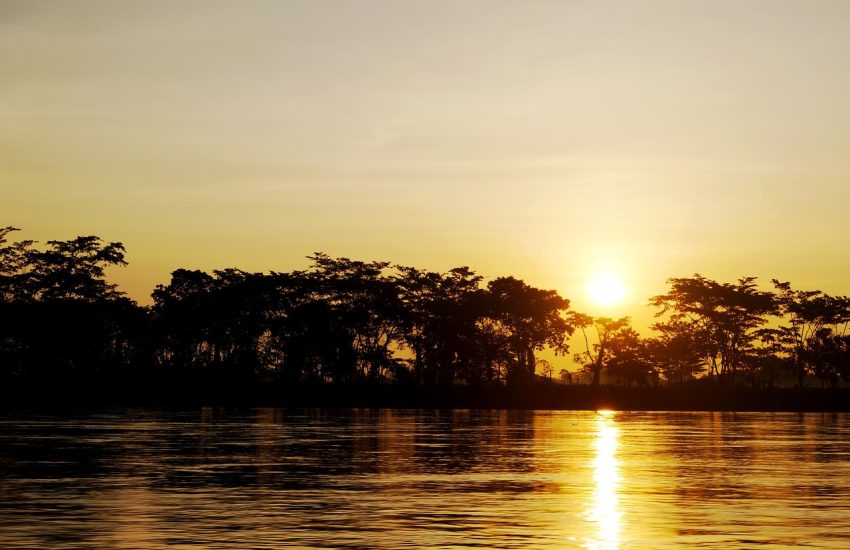When I lived with the Yebámasa Indians on the Río Piraparaná in South-East Colombia in 1977/78, one day, a group of Indians from Síoro Jáiro, a place directly on the Piraparaná consisting of four palm-leaf malocas, decided that they wanted to travel to the mission town of Mitú by canoe. Mitú was approximately 300 miles by river from Síoro Jáiro.
To travel there by canoe meant that one needed to paddle mostly against the current of the rivers and that the canoes and their content had to be carried across several cachiveras (rapids) and over land from one river to another. Certainly, not a pleasure trip.
They were eight men and they had four canoes. During the season, they had collected enough gaucho (raw rubber) to make it worth their while to make the long trip to Mitú where they would be able to sell their rubber to the local Caja Agraria (Agri Bank) and buy things they needed, wanted, or desired. Unfortunately, they mostly bought things they desired instead of things they needed.
They had to fit all the rubber into the canoes together with the things they needed or wanted to carry with them. Each canoe had to hold two men, one at the bow and one at the stern. The rubber had been formed into soft floppy flat shapes called laminas (blades). The blades were about a quarter inch thick, one foot wide and four feet long and they were surprisingly heavy. They were rolled up together in bultos (bundles). I estimated each bundle to weigh about 50 pounds.
The Indian canoes were dugouts made by burning and chopping out a tree. They were about two feet wide and 15 – 20 feet long. They were hard to balance on the water and they capsized easily. The more load they contained, the more unstable they became.
The men approached me one afternoon and asked me if I would pack their stuff into their canoes for them. They would help me, they said. I was a bit taken aback by this somewhat preposterous request and responded in disbelief.
“Doing all the packing for you seems unpractical. I would have to do most of the work and the packing would take about six times as long. Would it not make more sense, if you do the packing and I help you?”
“No,” they said, “we cannot pack.”
“What?”
“Indians cannot pack canoes very well. It has been proven over and over. Besides,” they said, “the story of Warími explains why. Do you know the story?”
I admitted that I did not know the story.
“Oh, well, that explains your reaction.” they said. “Let us tell you the story.”
We sat down together at my triangular table-tree table and Ricardo, the oldest son of the Capitán (Chief), started telling me the story of Warími. Here a much-abridged version:
“Warími was one of the ancient Yebámasa, one of our tribal ancestors. He was very strong and super-intelligent. He was also a master of canoe packing. When he packed a canoe, everything would fit right into it. No crammy spots, no empty places. Everything was stacked into the canoe neatly and properly. No waste of space, no overloading, no loose items that could fall overboard. Nothing had to be left behind and still there was always enough space for the paddlers. Thousands of years ago, Warími came from far away. He came from Europe, across the Atlantic, and he had travelled up the Amazon river and the Pirá in a boat with a propeller, which he had invented. Warími was a white man. Unfortunately, after many adventures, he left us. He went back to Europe in his boat with the propeller without teaching the Yebámasa how to properly pack a canoe. This explains why white men can pack canoes so perfectly that no space is wasted. You are a white man. So, please pack our stuff into our canoes for us like white men do to make sure everything fits in and no space is wasted. If we pack the canoes ourselves, half of the rubber will be left on shore, there will be much wasted space, and the canoes will be so unstable that they will capsize at the first cachivera. So, please pack our canoes for us!”
What would you have done under these circumstances? I went ahead and packed their canoes for them.
For a while, I suspected that they had simply invented the entire Warími story in order to con me into doing all this tedious work for them. Later, I was able to verify that it was indeed a bonified mythical tale that was part of their oral tribal lore. But I never received an explanation for why the Indians would consider a white man their ancestor. Be that as is may, it was certainly a smart idea to use the myth to recruit me for this sweat job.
My Jewish grandmother used to say “Boy, don’t acquire so many skills. You may end up having to use them.” But in this case, I was trapped.
My packing skills were part of my whiteness. Unknowingly, I had become an early victim of CRT.
